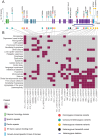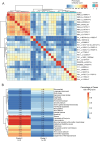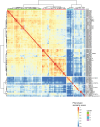This is a preprint.
Domain specific phenotypic expansion associated with variants in MACF1
- PMID: 40666329
- PMCID: PMC12262753
- DOI: 10.1101/2025.06.26.25330137
Domain specific phenotypic expansion associated with variants in MACF1
Abstract
Purpose: While heterozygous de novo missense variants in the microtubule-binding GAR domain of Microtubule-actin cross-linking factor 1 (MACF1) cause Lissencephaly 9 with Complex Brainstem Malformations [MIM #618325], the phenotypic impact of variants outside this domain remains unclear.
Methods: Through collaborative efforts, we assembled a cohort of 10 affected individuals from 8 unrelated families with either biallelic or monoallelic non-GAR domain MACF1 variants who exhibit partially overlapping yet unique phenotypic traits. Combined with previously reported cases, we analyzed genotype and phenotype data from 29 individuals using Human Phenotype Ontology (HPO)-based unsupervised hierarchical clustering.
Results: Clustering revealed two distinct phenotypic signatures, suggesting domain-specific effects. Variants outside the GAR domain associate with broader neurodevelopmental phenotypes and variable craniofacial and skeletal expressivity. Additionally, enrichment analysis (p < 0.001) using OMIM HPO sets supported these findings. In contrast to the GAR domain's strong correlation with lissencephaly and brainstem malformations, biallelic non-GAR domain MACF1 variants were linked to diverse developmental anomalies.
Conclusion: These results expand the phenotypic spectrum of MACF1-related disorders and highlight the relevance of domain-specific variant effects. Comprehensive genetic and phenotypic assessments are essential for understanding the role of MACF1 in development, informing diagnosis, and guiding future research on cytoskeletal regulation in neurodevelopment.
Keywords: Actin-microtubule cross-linking; Domain-specific phenotypes; GAR domain; Lissencephaly; MACF1 variants; Neurodevelopmental disorder; Phenotypic variability.
Conflict of interest statement
Competing interests James R. Lupski is a consultant for Genome International. Jennifer E. Posey serves on the Scientific Advisory Board of MaddieBio. Davut Pehlivan provides consulting service for Ionis Pharmaceuticals and Acadia Pharmaceuticals. The Department of Molecular and Human Genetics at Baylor College of Medicine receives revenue from clinical genetic testing completed at Baylor Genetics Laboratory. The remaining authors declare that they have no competing interests.
Figures





References
Publication types
Grants and funding
LinkOut - more resources
Full Text Sources
